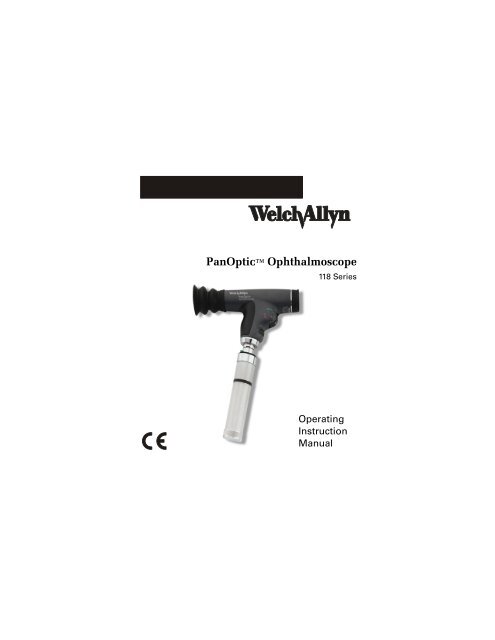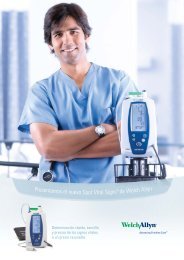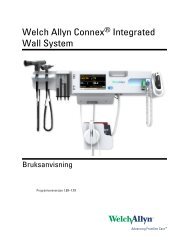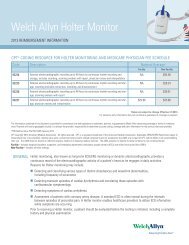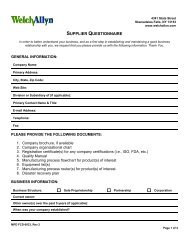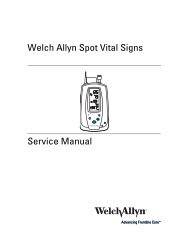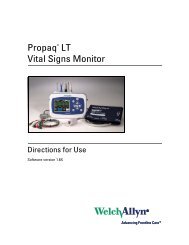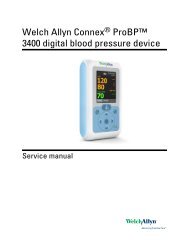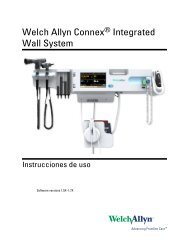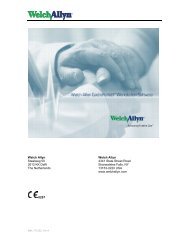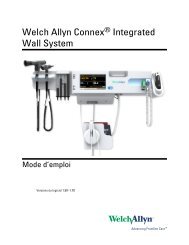PanOptic User's Manual - Welch Allyn
PanOptic User's Manual - Welch Allyn
PanOptic User's Manual - Welch Allyn
You also want an ePaper? Increase the reach of your titles
YUMPU automatically turns print PDFs into web optimized ePapers that Google loves.
<strong>PanOptic</strong> Ophthalmoscope118 SeriesOperatingInstruction<strong>Manual</strong>
This product is protected by the following US patents: 6,065,837; 6,390,625;6,409,341; 6,527,390; U.S. Pub. No. US20020097379; other patents pending.AU App. No. 16331/100; AU App. No. 2001263366; CA App. No. 2,352,148; CAApp. No. 2,409,596; PRC App. No. 99813584.4; EP App. No. 99959085.4; EP App.No. 01937653.2; JP App. No. 2000-583418.©2001 by <strong>Welch</strong> <strong>Allyn</strong>, Inc. All rights reserved. No part of this manualmay be reproduced or transmitted in any form or by any means, electronicor mechanical, including photocopy, without prior consent in writingfrom <strong>Welch</strong> <strong>Allyn</strong>. Printed in the U.S.A.
Table of ContentsSymbols. . . . . . . . . . . . . . . . . . . . . . . . . . . . . . . . . . . . . . . .1Warnings and Cautions . . . . . . . . . . . . . . . . . . . . . . . . . . .2The <strong>PanOptic</strong> Ophthalmoscope . . . . . . . . . . . . . . . .4Set-up Instructions . . . . . . . . . . . . . . . . . . . . . . . . . . . . . . .5Conducting an Examination with the <strong>PanOptic</strong>Ophthalmoscope. . . . . . . . . . . . . . . . . . . . . . . . . . . . . . . . .7Apertures and Filters . . . . . . . . . . . . . . . . . . . . . . . . . . . .12The Eye . . . . . . . . . . . . . . . . . . . . . . . . . . . . . . . . . . . . . . .14Lamp Replacement Instructions . . . . . . . . . . . . . . . . . . .15Cleaning and Repair Instructions. . . . . . . . . . . . . . . . . . .16Troubleshooting . . . . . . . . . . . . . . . . . . . . . . . . . . . . . . . .17Accessory and Replacement Parts List . . . . . . . . . . . . . .19Service and Warranty Information. . . . . . . . . . . . . . . . . .20Specifications . . . . . . . . . . . . . . . . . . . . . . . . . . . . . . . . . .23
SymbolsAttention. Read Operating <strong>Manual</strong> for Cautions and Instructionsfor Use.TYPE BF – Indicates this is a product with Type BF appliedparts (the patient eyecup).The CE mark on this product indicates it has been tested toand conforms with the provisions noted within the 93/42/EEC Medical Device Directive.1
Warnings and CautionsCAUTION: To minimize lamp housing temperatures, ontimeshould not exceed 2 minutes with off-time not less than10 minutes.CAUTION: No acute optical radiation hazards are identifiedfor ophthalmoscopes. However, <strong>Welch</strong> <strong>Allyn</strong> recommendslimiting the intensity of the light directed into the patient’seye to the minimum level that is necessary for diagnosis.Infants, aphakes, and persons with diseased eyes are at agreater risk. The risk is also increased if the examined personhas had any exposure with the same instrument or anyother ophthalmic instrument using a visible light sourcewithin the previous 24 hours. This will apply particularly ifthe eye has had exposure to retinal photography. Theintended use of this device is for routine ophthalmic examson the order of typically less than 60 seconds per eye.Although there is a benefit versus risk factor in any medicalprocedure, these more complicated exams should notexceed a three minute exam time in 24 hours. Significantuse of this device beyond its intended use is not recommended;it may cause harm to the eyes.Use only <strong>PanOptic</strong> Patient Eyecups (part number 118092)with this product.CAUTION: Federal Law restricts this device to sale by ororder of a physician.CAUTION: Spectrally weighted photochemical radiance L Band L A give a measure of the potential hazard that exists fora beam of light to cause photochemical damage to the retina.L B gives the measure for eyes in which a crystalline lens isnot in place. L A gives this measure either for eyes in whichthe crystalline lens has been removed (aphakes) and has notbeen replaced by a UV-blocking lens or for the eyes of veryyoung children.2
The value stated for this ophthalmoscope gives a measure of hazardpotential when the instrument is operated at maximum intensityand maximum aperture. Values of L B or L A over 684mW/(cm 2 *sr)are considered high.The retinal exposure dose for a photochemical hazard is a productof the radiance and the exposure time. For instance, at a radiancelevel of 684mW/(cm 2 *sr), a 3-minute exposure would produce aretinal exposure dose level at the recommended limit. If the valueof radiance were reduced to 342mW/(cm 2 *sr), twice that time (i.e. 6minutes) is needed to reach the recommended limit. Therecommended exposure dose is based on calculations using theAmerican Conference of Governmental Industrial Hygienists(ACGIH) Threshold Limit Values for Chemical Substances andPhysical Agents (1995-1996 Edition).The 118 Series Ophthalmoscope has spectrally weightedphotochemical radiances at maximum intensity andmaximum aperture of .281 W/(cm 2 *sr) for L B and .300 W/(cm 2 *sr) for L A (aphake). The relative spectral output of thedevice is shown below.3053303553804054304554805055305555806056306556807057307557808058308558809059309559801005103010551080W a velength (nm )3
The <strong>PanOptic</strong> OphthalmoscopeTransparency of the cornea, lens and vitreous humor permits thepractitioner to directly view arteries, veins, and the optic nerve ofthe retina.Direct observation of the structures of the fundus through a <strong>PanOptic</strong>Ophthalmoscope may show disease of the eye itself or mayreveal abnormalities indicative of disease elsewhere in the body.Among the most important of these are vascular changes due to diabetesor hypertension and swelling of the optic nerve head due topapilledema or optic neuritis. In this sense, the eye serves as a windowthrough which many valuable clinical evaluations may bemade.When a preliminary diagnosis of an imminently dangerous eye condition,such as acute (angle-closure) glaucoma or retinal detachment,is made by the examiner, prompt referral to an eye specialistmay prevent irreversible damage. Or, when distressing but lessurgent conditions, such as visual impairment due to cataract or vitreousfloaters, are recognized, the patient can be reassured andreferred.AFBECDA Patient Eyecup D Aperture/Filter DialB Patient’s Side E Focusing WheelC Soft Grip Handle F Practitioner’s Side Brow Rest4
Set-up InstructionsAttaching the <strong>PanOptic</strong> Ophthalmoscope head to a<strong>Welch</strong> <strong>Allyn</strong> Power SourceAlign cutouts in the <strong>PanOptic</strong> Ophthalmoscope base with lugs onpower source. (The <strong>PanOptic</strong> Ophthalmoscope fits all 3.5v <strong>Welch</strong><strong>Allyn</strong> power sources.) Push in slightly and turn 90 degrees.Attaching the Patient Eyecup to <strong>PanOptic</strong>TURN HANDLECOUNTER-CLOCKWISEUse only <strong>PanOptic</strong> Patient Eyecups (part number 118092)with this product.Insert eyecup into the patient’s sideof the instrument. Push and twist inone motion until you feel the two“lock” together.See “Accessory and ReplacementParts List” on page 19 to reorder new<strong>PanOptic</strong> Patient Eyecups.TWIST5
Attaching Corneal Viewing Lens to <strong>PanOptic</strong> (Model11820 only)Insert Corneal Viewing Lens into patient’s side of the instrument.Push and twist in one motion until you feel the two “lock” togetheras shown on page 5, except replacing Patient Eyecup with the CornealViewing Lens. Verify that the line on the lens housing isaligned with the top seam of the <strong>PanOptic</strong> instrument6
Conducting an Examination with the <strong>PanOptic</strong>Ophthalmoscope1. To examine the right eye, stand or sit to the patient’s right side.2. Remove Spectacles (preferred,but not required).3. Look through the scope (fromthe doctor’s side) with yourthumb on the focusing wheel.Focus the scope on an objectroughly 15 feet away. (Thisprocedure will make anyadjustments for your own eye’scorrective needs.)4. Start with the small aperture(green line position on theaperture dial).7
5. Turn the scope on (using any<strong>Welch</strong> <strong>Allyn</strong> 3.5V powersource). Adjust light intensityrheostat to desired position.You are now ready to begin the examination:6. Examiner should be positionedapproximately 15 degrees to thetemporal side of the patient.7. Instruct the patient to lookstraight ahead at a distantobject.8. Begin from about 6 inches away,looking through the scope andshining the light at the patient’seye while looking for the redretinal reflex.9. Rest your left hand on thepatient’s forehead. (optional)8
10. Slowly follow the red reflextoward the patient and into thepupil. Get as close as possiblefor the optimum view (theeyecup should contact thepatient’s brow).11. Once you have a stable view ofthe fundus rotate the focusingwheel until you have a crispview of the optic disc and thevessels surrounding it.Note:For the largest view,compress the eyecuphalfway against thepatient’s brow. This enablesthe user to view the entireoptic disc plus manysurrounding vessels (about25° field of view) at onetime.9
12. Examine the optic disc forclarity of outline, color,elevation and condition of thevessels. Follow each vessel asfar to the periphery as you can.To locate the macula, focus onthe disc, then move the lightapproximately one (1) discdiameter temporally. You mayalso have the patient look at thelight of the ophthalmoscope,which will automatically placethe macula in full view. Examine for abnormalities in themacular area. The red-free filter facilitates viewing of the centerof the macula, or the fovea.13. To examine the extreme periphery instruct the patient to:A look up for examination of the superior retinaB look down for examination of the inferior retinaC look temporally for examination of the temporal retinaD look nasally for examination of the nasal retina.This routine will reveal almost any abnormality that occurs inthe fundus.10
14. To examine the left eye, repeatthe procedure outlined above.However, unlike traditionalophthalmoscopy, a uniquefeature of <strong>PanOptic</strong> is that theexaminer does not have toswitch to his/her left eye. Thepractitioner can use either eyeto examine either patient eyebecause of the greater workingdistance between patient andpractitioner. This permits thosewho are strongly dominant inone eye to always use that eyein the fundus exam.11
Apertures and FiltersThere is a wide range of practical apertures and filters to selectfrom: small spot, large spot, micro spot, slit aperture, red-free filter,cobalt blue filter (optional), and half-moon aperture (optional).1. Small Aperture: Provides easy view of the fundusthrough an undilated pupil. Always start theexamination with this aperture and proceed to microaperture if pupil is particularly small and/or sensitive tolight. This position is the “Home” position on theaperture dial and is denoted by the green marking.2. Large Aperture: Standard aperture for dilated pupilexamination of the eye.3. Micro Spot Aperture: Allows easy entry in very small,undilated pupils.4. Slit Aperture (Models 11810, 11820 only): Helpful indetermining various elevations of lesions, particularlytumors and edematous discs.5. Red-Free Filter (Model 11810, 11820 only): This filterexcludes red rays from the examination field: this issuperior to ordinary light in viewing slight alterationsin vessels, minute retinal hemorrhages, ill-defined exudatesand obscure changes in the macula. The nerve fibers becomevisible and the observer may note the disappearance of suchfibers, as in optic nerve atrophy. The background appears gray,the disc appears white, the macula appears yellow, the fundusreflex is intense and the vessels appear almost black. This filteris also used to help distinguish veins from arteries; veins stay12
elatively blue, but oxygenated arterial blood makes arteriesappear blacker. This greater contrast makes differentiationeasier for the examiner.6. Cobalt Blue Filter (Model 11820 only): In conjunctionwith fluorescein dye applied topically to the corneaand an add-on magnifying lens (included), this filter ishelpful in detecting corneal abrasions and foreignbodies. In this way, it can be used as a surrogate to aWoods Light.7. Half-Moon Aperture (11810 Only): Provides acombination of depth perception and field-of view.13
The EyeIn addition to examination of the fundus, the <strong>PanOptic</strong> Ophthalmoscopeis a useful diagnostic aid in studying other ocular structures.The light beam can be used to illuminate the cornea and the iris fordetecting foreign bodies in the cornea and irregularities of thepupil.The practitioner can also easily detect lens opacities by looking atthe pupil through an add-on corneal viewing lens. In the same manner,vitreous opacities can be detected by having the patient look upand down, to the right and to the left. Any vitreous opacities will beseen moving across the pupillary area as the eye changes position orcomes back to the primary position.A) MaculaB) Vitreous humorC) ScleraD) ChoroidE) RetinaF) Ora SerrataG) Canal of SchlemmH) Anterior chamberI) IrisJ) CorneaK) Ciliary bodyL) Zonule (Suspensory Ligament)M) ConjunctivaN) LensO) Hyaloid canalP) Central retinal veinQ) Optic nerveR) Central retinal artery14
Lamp Replacement InstructionsLamp Replacement Caution: Halogen lamps are pressurized to providemaximum efficiency and illumination. Mistreatment maycause shattering. Protect lamp surface against abrasion andscratches. Verify power is off when replacing lamp. Dispose of lampwith care.CAUTION: Lamps may be hot. Lamp should be allowed tocool before removal. Use only <strong>Welch</strong> <strong>Allyn</strong> model 03800lamp with this productUse your fingernail ora small prying instrumentto remove thelamp from the ophthalmoscopeheadbase.ALIGN TABTo insert the newlamp, align tab onlamp with notch inthe base of the ophthalmoscopeheadand push inwarduntil firmly seated.15
Cleaning and Repair InstructionsCleaning and repairs (with exception of the lamp replacement)beyond what is specified in the “general cleaning instructions” sectionshould be performed at the factory.General Cleaning InstructionsNOTE: Excess solution entering the optical assembly could damageinternal components. Use caution to ensure cloth is not saturatedwith solution.This is a precision optical instrument. Please follow these specificcleaning requirements:• Do not use any solvent based cleaners on the lenses. Use onlythe supplied cleaning cloth on the lenses.• The <strong>PanOptic</strong> Ophthalmoscope is Non-sterilizable.• Disinfect housing using soft cloth moistened with alcohol.• Clean the Patient Eyecup by any of the following methods:1. Soft cloth/cotton swab moistened with alcohol.2. Soaking in gluteraldehyde based solutions (i.e. CidexOPA).NOTE: For disinfection time / procedure requirements it isrecommneded that you follow the directions of thespecific brand you are using.3. Autoclaving.• Do not use acetone based products or other harsh chemicals.No other preventative maintenance is necessary for this product.16
TroubleshootingTrouble AreaNo Light outputSpot is notcentered.Not achieving fullor expected view.Possible CauseAperture dial isin-betweenpositionsLamp burned out.Wrong lamp/incorrect <strong>Welch</strong><strong>Allyn</strong> lamp/non-<strong>Welch</strong> <strong>Allyn</strong> lamp.The battery handlehas completelydischarged.The aperture dialis not centered.Unit is not inproper operatingposition.CorrectiveActionRotate theaperture dial.Replace the lampusing <strong>Welch</strong> <strong>Allyn</strong>part number03800.Replace lampusing <strong>Welch</strong> <strong>Allyn</strong>part number03800.Charge the handle,check the battery,and/or the charger.Move aperture dialto the full detentposition.Ensure that theeyecup is slightlycompressedduring theprocedure.17
Trouble AreaCan not obtainsharp focus/hazyview.Dim Light OutputGlare in viewCannot attach topower handle.Possible CauseThe lenses aredirty.Lamp pin notengaged in slotFilm on OpticsThe handle is notfully charged.Fingerprints ordirt on theobjective (Patient’sSide) lensLamp is not fullyinserted.CorrectiveActionClean the lenseswith the providedcleaning cloth.Insert the lampwith pin firmlyseated in slot.Clean the lenseswith the providedcleaning cloth.Charge the handle,check the batteryand/or the chargerClean the objective(Patient’s Side)lens with theprovided cleaningcloth.Insert the lampwith pin firmlyseated in slot.18
Accessory and Replacement Parts List135 6OR24ItemNo.Description Product #1 Corneal Viewing Lens11875(model no. 11820 only)2 Patient Eyecups (Package of five 11870(5) each 118092)3 Patient’s Side Bumper 1180514 Lamp 038005 Chrome Ring 1180276 Practitioner’s Side Brow Rest 1180527 Cleaning Cloth (not shown) 1187319
Service and Warranty InformationServiceFor customers in North America, please return instruments requiringservice to a <strong>Welch</strong> <strong>Allyn</strong> Technical Service Department listedbelow or to an authorized <strong>Welch</strong> <strong>Allyn</strong> distributor.Technical Service DepartmentUSA:<strong>Welch</strong> <strong>Allyn</strong>, Inc.4341 State Street RoadSkaneateles Falls, NY 13153-0220 USATelephone: 800-669-9771Fax: 315-685-4653Canada:<strong>Welch</strong> <strong>Allyn</strong>, Ltd. - Canada160 Matheson Blvd. E., Unit #2Mississauga, Canada L4Z 1V4Phone: 905-890-0004Fax: 905-890-000820
For customers outside of North America, return your unit to a local,authorized <strong>Welch</strong> <strong>Allyn</strong> distributor or to your nearest <strong>Welch</strong> <strong>Allyn</strong>service center.<strong>Welch</strong> <strong>Allyn</strong>, Ltd. – UK<strong>Welch</strong> <strong>Allyn</strong> FranceCublington Road814 rue Charles de GaulleAston Abbots, Buckinghamshire 77100 Mareuil les MeauxEngland HP22 4NDFrancePhone: 011-44-1296-689905 Phone: 011-33 1 60 06 33 66Fax: 011-44-1296-682104 Fax: 011-33 1 60 09 67 97<strong>Welch</strong> <strong>Allyn</strong>, GmbH PSC <strong>Welch</strong> <strong>Allyn</strong>, LTD - SingaporeZollerstrasse 2-4 300 Beach Road #25-0872417 Juningen, Germany The ConcoursePhone: 011-49-7477-927173 Singapore 199589Fax: 011-49-7477-927193 Phone: 011-65-291-0882Fax: 011-65-291-5780<strong>Welch</strong> <strong>Allyn</strong> China Service CenterRoom 708, 227 Huang Pi Road, NorthCentral PlazaShanghai 200003, ChinaPhone: 011-86-21-6327-9631Fax: 011-86-21-6327-9632<strong>Welch</strong> <strong>Allyn</strong>, Ltd. - AustraliaMetro Center Unit 538 South StreetRydalmere NSW 2116, AustraliaPhone: 011-(612) 9638-3000Fax: 011-(612) 9638-3500For service in Latin America and the Caribbean region, contact:MD International11300 N.W. 41st StreetMiami, FL 33178 USAPhone: 1-305-669-9003Fax: 1-305-669-197121
<strong>PanOptic</strong> Ophthalmoscope Warranty<strong>Welch</strong> <strong>Allyn</strong>, Inc. warrants the No. 11810, 11820 <strong>PanOptic</strong> Ophthalmoscopeto be free of original defects in material and workmanshipand to perform in accordance with manufacturer’s specifications fora period of one year from the date of purchase. If this instrument orany component thereof is found to be defective or at variance withthe manufacturer’s specifications during the warranty period,<strong>Welch</strong> <strong>Allyn</strong> will repair or replace the instrument or component(s)at no cost to the purchaser.This warranty only applies to instruments purchased new from<strong>Welch</strong> <strong>Allyn</strong> or its authorized distributors or representatives. Thepurchaser must return the instrument directly to <strong>Welch</strong> <strong>Allyn</strong> or anauthorized distributor or representative and bear the costs of shipping.This warranty does not cover breakage or failure due to tampering,misuse, neglect, accidents, modification or shipping, and is void ifthe instrument is not used in accordance with manufacturer’s recommendationsor if repaired or serviced by other than <strong>Welch</strong> <strong>Allyn</strong>or a <strong>Welch</strong> <strong>Allyn</strong> authorized representative.No other express or implied warranty is given.22
SpecificationsModel Number11810 <strong>PanOptic</strong> Ophthalmoscope without Cobalt Blue Filter11820 <strong>PanOptic</strong> Ophthalmoscope with Cobalt Blue Filter andAdd-on Corneal Viewing LensDimensions5.125”L x 1.4”W x 3.750”H without eyecupEyecup 1.45”LWeight.48 lbs without eyecup.50 lb with eyecupApprovalsEN60601-1IEC 60601-1-2CAN/CSA-C22.2 No. 601.1-M90UL 2601-1, Second Edition, 1997Equipment ClassificationIPXØ Equipment not protected against the ingress of water.Equipment not suitable for use in the presence of a flammableanesthetic.EnvironmentTransport/ -20°C - 49°C, 95% Rh max, 500hPa - 1060 hPa,Storage: altitudeOperating: 10°C - 49°C, 95% Rh max, 500 hPa - 1060 hPa,altitudeCAUTION: Federal Law restricts this device to sale by or order ofa physician.23
<strong>Welch</strong> <strong>Allyn</strong>, Inc.4341 State Street RoadSkaneateles, NY 13153-0220Tel: (800) 535-6663Printed in U.S.A.Part No. 118088 Rev. E


